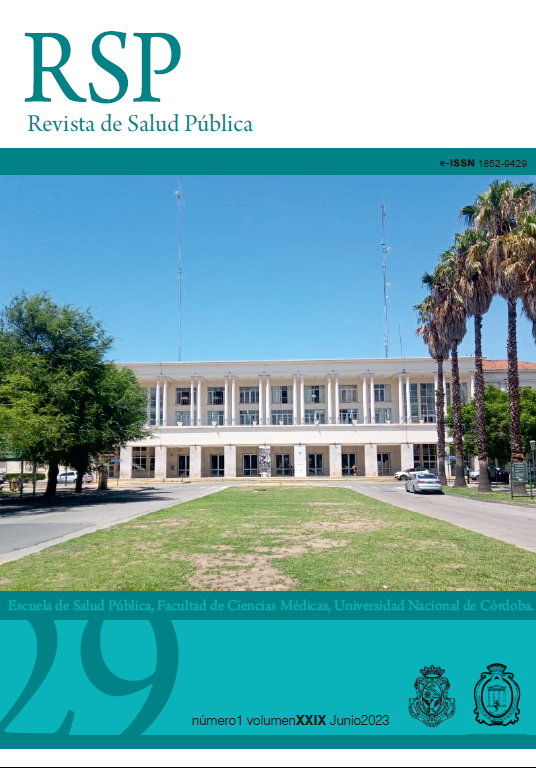Food card: what defines a better purchase? for whom? Implementation operation in the Province of Cordoba
DOI:
https://doi.org/10.31052/1853.1180.v29.n1.39652Keywords:
social policies, food, implications, CórdobaAbstract
Introduction: The Food Card (TA, Spanish acronym) was a strategy of the plan Argentina Against Hunger aimed at promoting and strengthening access to the Basic Food Basket for the population living in poverty, in order to improve the nutritional quality of their diet. Distribution and implementation of TA in the province of Cordoba (February 27 to March 12, 2020) had the active participation of the School of Nutrition (UNC) in its planning, execution, and evaluation.
Objectives: The aim of this study is to describe the target population of the Food Card in the province of Cordoba and analyze the main implications associated with "the best food purchase."
Materials and methods: A qualitative and quantitative approach (n = 9571 women) was used. Techniques included a semi-structured questionnaire and participatory workshops. Statistic, descriptive, inferential, and content analysis were conducted on the main implications regarding "the best food purchase."
Results: There was marked heterogeneity in material living conditions (basic needs), services (installed water network), cooking equipment (oven, refrigerator), places of purchase (supermarkets, neighborhood shops, limited access to varied food), state and community social programs (community dining rooms, support networks). Implications that define the "best purchase" included: acquiring a specific food item; a good cost/benefit ratio; coverage of healthy food; treating oneself; meeting daily needs; safe food; good treatment; choosing where to buy; proximity.
Conclusions: This policy can be seen as a "first" compensation to reduce the structural food gap in Argentina. It raises the question of what "eating well" means for each individual. "The best purchase" is defined based on these implications.
Keywords: social policies, food, implications, Cordoba.
Downloads
References
Huergo J, Abraham MD, Butinof M. Informe técnico: “Entrega de la Tarjeta Alimentar en la Provincia de Córdoba”. Proyecto de cooperación interactoral para la implementación del Plan Argentina contra el Hambre [Tarjeta AlimentAR] en la Provincia de Córdoba Convenio entre el Ministerio de Desarrollo Social, Provincia de Córdoba y la Escuela de Nutrición, Universidad Nacional de Córdoba. 2020.
Bainotti F, Busleimán M.V. Coreografías del cuidado en barrios socio-segregados de la ciudad de Córdoba: familias y organizaciones comunitarias", en Tuñón I, Huergo J, Ibáñez I (Coord), Dossier Experiencias de infancias y prácticas de cuidado en tiempos de pandemia, Cuadernos del CIPeCo, Vol. 1 Nº2, ISSN 2796-8383. 2021
Contreras Hernández, J. y Arnaiz, M. Alimentación y Cultura: Perspectivas Antropológicas. Barcelona: Editorial Ariel. 2005.
Sampieri Hernández, R. et al. Recolección de datos cuantitativos. En: Metodología de la Investigación. México: Mc Graw Hill. 2005.
CIPPES. Crecimiento y profundización de la pobreza en la provincia de Córdoba [en línea]. Córdoba: CIPPES 2019. Disponible en: http://www.cippes.org/noticia/25/crecimiento-y-profundizacin-de-la-pobreza-en-l-provincia-de-crdoba
ODSA-UCA. La pobreza como privación más allá de los ingresos (2010-2019). Evolución de carencias monetarias y no monetarias a lo largo de la última década. 2020. Disponible en: https://uca.edu.ar/es/noticias/la-pobreza-mas-alla-de-los-ingresos-informe-sobre-pobreza-multidimensional-2010-2019
Salvia, A:, Bonfiglio, J.I.; Robles, R.; Vera, J. Efectos de la pandemia COVID-19 sobre la dinámica del bienestar en la Argentina urbana. Una mirada multidimensional acerca del impacto heterogéneo de la crisis tras una década de estancamiento económico (2010-2020). Documento Estadístico– Barómetro de la Deuda Social Argentina - 1ª ed. Ciudad Autónoma de Buenos Aires: Educa. 2021.
Gracia-Arnaiz M. Comer bien, comer mal: la medicalización del comportamiento alimentario. Salud Publica Mex 2007;49:236-242
Tuñón, I.; Poy, S. y Salvia, A. La tarjeta ALIMENTAR a un año de su implementación. Una caracterización sociodemográfica, socio alimentaria y socioeconómica de los hogares destinatarios. Documento de investigación– Barómetro de la Deuda Social Argentina - 1ª ed. Ciudad Autónoma de Buenos Aires: Educa. 2021.
Ministerio de Desarrollo Social de la Nación. Reporte de Monitoreo. Tarjeta Alimentar – 4° trimestre 2020. SIEMPRO.
UNICEF, Ministerio de Desarrollo Social de la Nación.Evaluación de la Tarjeta Alimentar. Síntesis ejecutiva. Buenos Aires: UNICEF. 2022. Disponible en: https://www.argentina.gob.ar/sites/default/files/2021/04/tarjeta_alimentar_unicef_mds_02_jun_2022.pdf
Britos S., Albornoz M. Calidad de dieta en hogares con niños, niñas y adolescentes y calidad nutricional de los consumos con la Tarjeta Alimentar. Ponencia presentada en las XVI Jornadas Argentinas de Estudios de Población III Congreso Internacional de Población del Cono Sur. 2021.
García Canclini N. El consumo sirve para pensar. En: García Canclini: Consumidores y ciudadanos. Conflictos multiculturales de la globalización. México: Grijalbo. 1995.
Ibañez, I.D.; Huergo, J. Encima que les dan, eligen, políticas alimentarias, cuerpos y emociones de niños/as de sectores populares. Centro de Investigaciones y Estudios sobre Cultura y Sociedad. Revista Latinoamericana de Estudios sobre Cuerpos, Emociones y Sociedad; 8; 7-2012; 29-42.
Danani, C. La gestión de la política social: un intento de aportar a su problematización. En: Repetto F., Chiara V, Di Virgilio M (Coord). Gestión de la política social: conceptos y herramientas. Buenos Aires: Prometeo. 2009.
Downloads
Published
Issue
Section
License
Copyright (c) 2023 Escuela de Salud Pública y Ambiente. Facultad de Ciencias Médicas. Universidad Nacional de Córdoba

This work is licensed under a Creative Commons Attribution-NonCommercial 4.0 International License.
Authors who have publications with this journal agree to the following terms:
The generation of derivative works is permitted as long as it is not done for commercial purposes.
The original work may not be used for commercial purposes.
Authors are allowed and encouraged to disseminate their work through professional social networks or on their website, after the publication process, in order to increase the visibility of their research.







